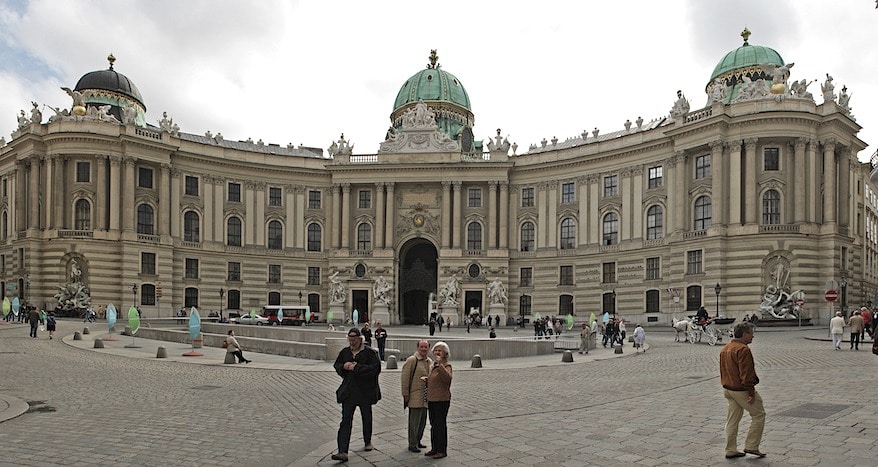 By Jacqueline Swartz
By Jacqueline Swartz
Dining at quirky cafes near the city’s oldest farmer’s market, dancing to a music festival on an island stretching along the Danube river – it’s hard to imagine Vienna as a museum piece, a monument to the glory of the Hapsburg Empire.
For centuries, it was a major power. The seat of the Holy Roman Empire, Vienna became the center of the Hapsburg Dynasty and the Austro-Hungarian Empire, which included 15 different nationalities. It was a European musical powerhouse, with Mozart and Beethoven just two of its resident luminaries. Coffee houses were a way of life – and still are – thanks partly to the coffee beans brought in by the Ottoman Turks, whose 1683 siege failed. Vienna’s fin de siècle impressed 19th Century Europe with its swirling Art Nouveau paintings and its innovative architecture.
Then came two world wars and a dreary period of postwar recovery. After the Iron Curtain fell in 1991, Berlin and Prague became hipster haunts. Vienna seemed overshadowed; stuck in the past, getting by on opera and apple strudel.
Anyone there in recent years, however, will tell a different story. Vienna is a city humming with creative energy. The grand 19th-century buildings that define the city co-exist with cafés, galleries and boutiques in revitalized neighborhoods. This smallish, walkable city is both trendy and user-friendly. It comes with a quiet, efficient subway that looks and feels first class.
In the cool Spittelberg area, with its low-rise buildings and cobblestone streets, check out Das Moebel, a café known for its brunches. Here you can try out (and buy) the furniture sold at the Das Moebel store,
A former red-light district, Gürtel, became the site of bars and clubs, which attract the late-night crowds to their edgy atmosphere and electronic music. Clubs are tucked within the arches beneath an elevated railway bridge designed by architect, Otto Wagner, known for his art nouveau subway stations and the beautiful Karlsplatz entrance pavilion. One of the most well-known and authentic clubs, Rhiz-Bar Modern, describes itself as “contemporary underground” and offers everything from trance-like electronica to gritty punk.
This former capital of the Hapsburg Empire can never forget its royal past, of course, not with so many baroque buildings, formal gardens and a constant schedule of concerts.
The Palmenhaus, once a greenhouse adjacent to the Imperial Hofburg Palace, is an example of new uses for old grandeur. After sitting empty for decades, it is now a trendy restaurant, open from lunch to late at night, with dishes like goat cheese with beetroot, fig and pomegranate, and a local lake trout with fennel. Few restaurants are blessed with such a setting – a high arched glass ceiling and palm trees next to the Imperial Palace of Austria’s last Emperor. Outside, a broad terrace overlooks the former royal gardens. After lunch, visit the Hofburg Palace, the Hapsburg residence for 600 years, and see some of the Imperial living quarters of Emperor Franz Joseph and his wife, Elisabeth, the much-mythologized Sisi.
Urban Renewal Hapsburg Style
Franz Joseph authorized the greatest European urban renewal project of the 19th century. With no need for the existing fortifications, the walls of the central city came down and the mid-to-late1800’s saw one grand structure rise after another. The Ring Boulevard is lined with over three miles of Neo-Gothic, Neo-Baroque and Neo-Classic buildings. These include the Opera House, the Burgtheatre and the Kunsthistorische Museum, with one of the world’s greatest collections of Old Masters. To get a sense of the whole of the Ring Boulevard, take the half-hour ride on the tram.
These Ring Boulevard buildings, with their imperial ornamentation, columns and statuary display the styles of past centuries, from Greek to Baroque. But there’s a more recent past that still beguiles today. Vienna’s golden fin de siècle, through the turn of the 20th century, made the city a cultural hub of Europe.
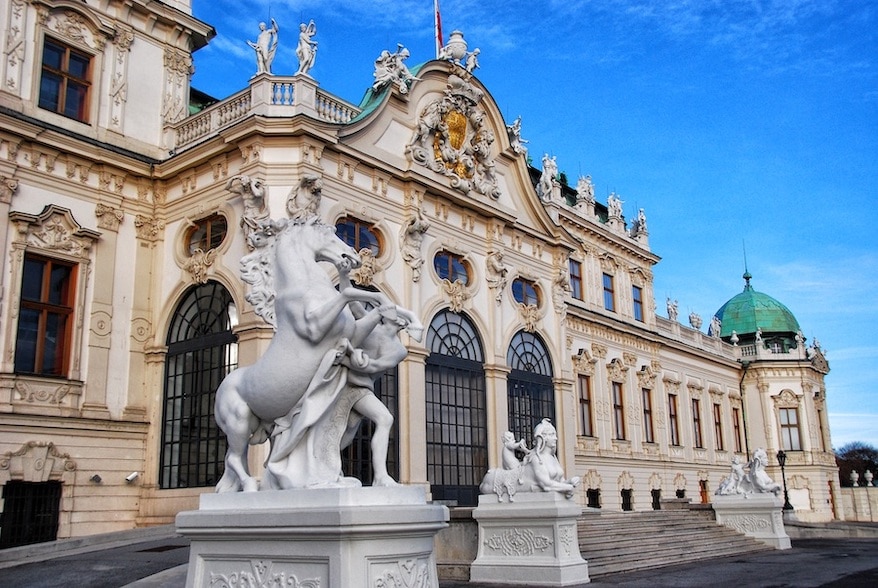
The Belvedere Museum includes two palaces built by Prince Eugene of Savoy. In the early 20th Century, Franz Ferdinand, the assassinated heir to the throne lived there. But most importantly the museum has Austria’s largest collection of Austrian art, including works by Gustav Klimt. “The Kiss” continues to draw visitors. Photo by Christian Stemper, Wien Tourismus.
What a time: Gustav Klimt was painting “The Kiss”, while Sigmund Freud was exploring the subconscious. Gustav Mahler was composing his brilliant, heartbreaking music (and lying on Freud’s couch anguishing over his wife, Alma Mahler’s infidelity). The Arts and Crafts movement, known as the Wiener Werkstatte, was thriving as a cooperative of artisans and artists, architects and designers. The idea was to create functional, decorative styles in glassware, textiles, furniture, even architecture.
The Museum of Applied Arts, called the MAK, sits on the Ring Boulevard and is a treasure house of objects used in daily life. From glassware to furniture, carpets to kitchens, the MAK opens our eyes to objects we often take for granted. Through October 2021, a special exhibit will highlight the considerable role of women designers and artisans in the Wiener Werkstatte.
A robust enthusiasm for art and design remains part of the Vienna vibe. Classic chocolatier Altmann & Kuehne on the Graben, the main downtown street for pedestrians only, sells miniature versions of its delicious candies. Chocolate-covered marzipan, nougat and more come in patterned boxes inspired by the Wiener Werkstatte artisan collective. The chocolatier won a design contest for its colorful miniature candy box shaped like a steamer trunk.
Vienna’s MuseumsQuartier
Nowhere is the new, dynamic Vienna linked more creatively to its past than in the MuseumsQuartier. One of the largest museum districts in the world, it opened in 2001, with museums, cafes restaurants and performance spaces covering an area of 60,000 square meters (14.8 acres), and cobblestone quadrangles tying it together. Emperor Franz Joseph’s former baroque cavalry stables are the flagship of the MQ, as it is called, and are repurposed as temporary exhibit spaces. The location is ideal: close by, to the northwest, is the Central District, including the Ring Boulevard; on another side is the 7th district, with design stores and cozy bistros.
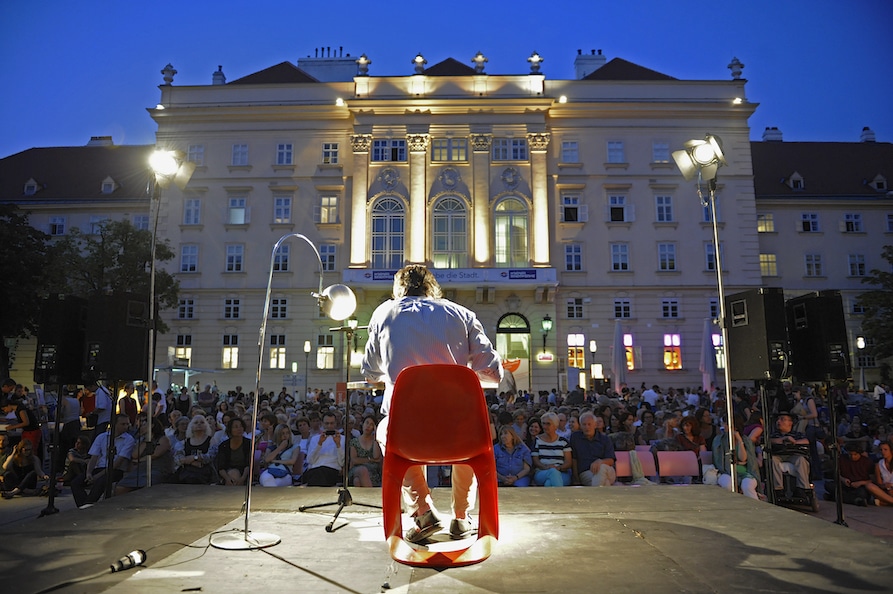
Reader at the Museums Quarter literature festival. Film, dance, literature as well as visual art animate the MQ.
“In the beginning, it was difficult to develop the concept, which is absolutely unique in size and variety,” remarks MusemsQuartier director, Christian Strasser. But the project became an urban success story. “Now, when people come to Vienna the MQ is the place to go.” On its periphery is Quartier 21. You never know what you will find there – open artists’ studios and fashion and design shops selling local creations. It’s edgy, yet welcoming.
The MQ is a great place to hang out, whether it’s in museums, stores, cafes – or just sitting around. When the weather gets warm, molded plastic seating in colors (that change every year) appears in the MQ courtyard. Designed by architects, these plastic chaises longues are typical of the new Vienna, where contemporary design complements Imperial buildings.
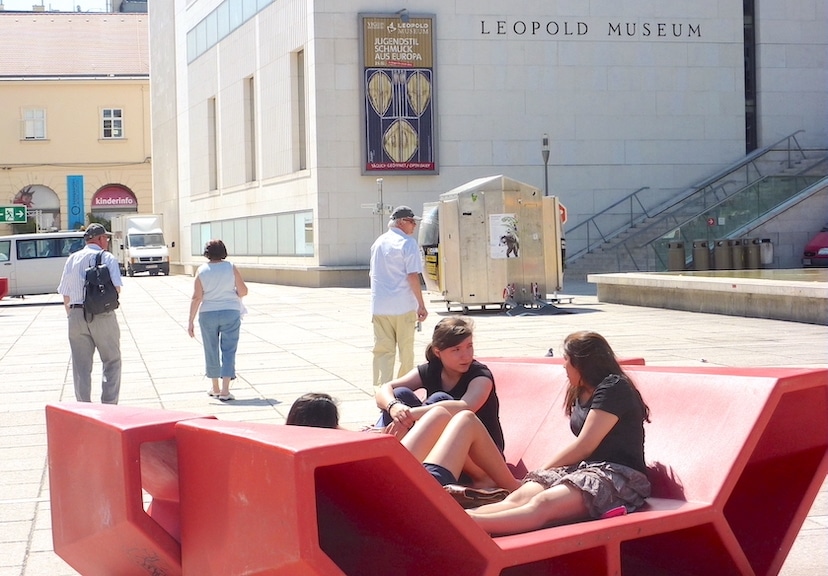
The distinctive outdoor lounge furniture has become a signature item at the MuseumsQuartier, both inviting and artistic. And it has caught on. Hanging out is part of the experience. Colors change periodically, the result of online polls. Photo by Jacqueline Swartz
After lunch at Milo, a casual restaurant café next to the MQ’s architecture museum, stroll over to the Leopold Museum. If you’re looking for Vienna’s fin-de-siecle, this is the go-to place. It has the world’s largest collection of works by figurative painter Egon Schiele; there are also paintings by his teacher, Gustav Klimt, as well as other contemporaries like Oskar Kokoschka.
A permanent exhibit called Vienna 1900 is a paradise of that period. On the wall are quotations from Sigmund Freud: “The unconscious is the true psychological reality.” Freud famously asked, “what do women want?” Schiele’s paintings of women in erotic reveries seem to hint at an answer. You can put on a set of earphones dangling from a circular couch and listened to Mahler’s bittersweet melodies. It’s the perfect soundtrack for a time of both elegance and dissonance, with a waning monarchy that would dissolve soon after the assassination of Archduke Franz Ferdinand in 1914. The shots that started World War I shattered Vienna’s empire.
In the architecture section of the Vienna 1900 exhibit is a video of some of Vienna’s famous buildings. The Secession Building, which opened in 1898, was the architectural expression of the movement started by Klimt. But why rely on a video when the real thing is just across town? One of Vienna’s signature buildings, the Secession is striking, with its white cubes topped by a gold-leaf covered dome. It still functions as a gallery and is well worth visiting. Don’t miss Klimt’s Beethoven Frieze.
Vienna Café Culture
Across the street, Vienna’s most popular market. The Naschmarkt goes on for almost a mile and includes a long row of outdoor restaurants. Several hundred years old, its outdoor stalls sell local produce, Middle Eastern and Asian foods as well as the pastries that Vienna is famous for. Just south, in the tiny but oh so cool 4th district, are cafes, boutiques and modern galleries. Gabarage makes upcycled products using industrial waste, plastics and other unwanted materials which are given new life as necklaces and lamps, tote bags and laptop sleeves. Nearby, Café Anzelgruber is a watering hole for locals.
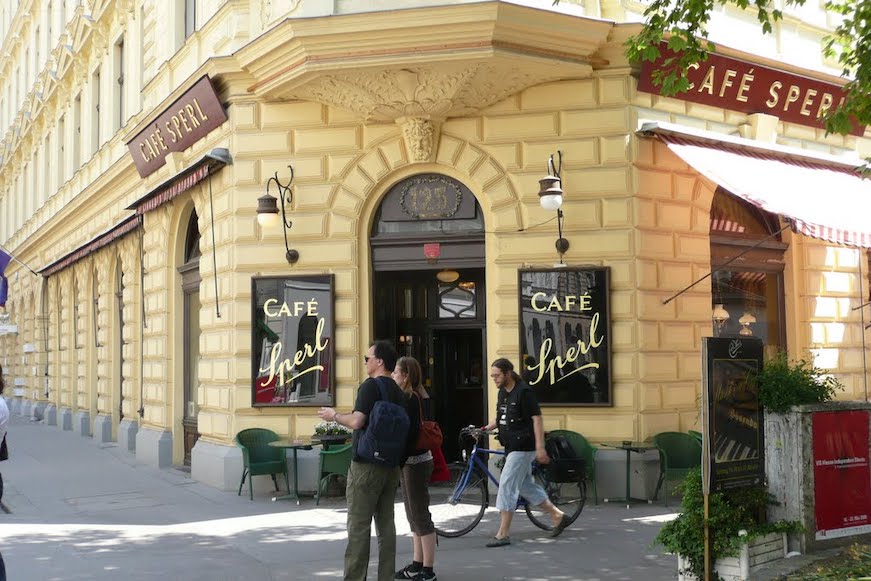
Cafe Sperl opened in the 1880’s, a time when Vienna’s grand cafes had their own clientele. Artist Gustav Klimt and his anti-establishment group called the Secessionists, used to meet at Cafe Sperl. Today, there’s a nascent movement in Vienna to get people to talk to humans instead of staring at screens. Photo by Jacqueline Swartz
But don’t ignore the older grand cafés. Café Sperl, just north of the Naschmarkt, dates from 1889 and has high ceilings, plush upholstery and brass fittings, and you can linger as long as you want over one of the newspapers attached to wooden sticks. From the extensive coffee menu, I choose a mélange, the Viennese version of café au lait, and a sublime piece of poppy seed strudel, mohnschnitte, with a thin, delicate crust.
There is also WienrSchnitzle, crepes and boiled beef. Viennese cuisine borrows many of its dishes from its old neighbors – Hungary, the Czech Republic, Poland, Serbia, Croatia, Slovakia. Before World War I, half the population of Vienna came from these countries. Today, with the European Union linking them to Austria, Vienna has regained its traditional mix of ethnicities.
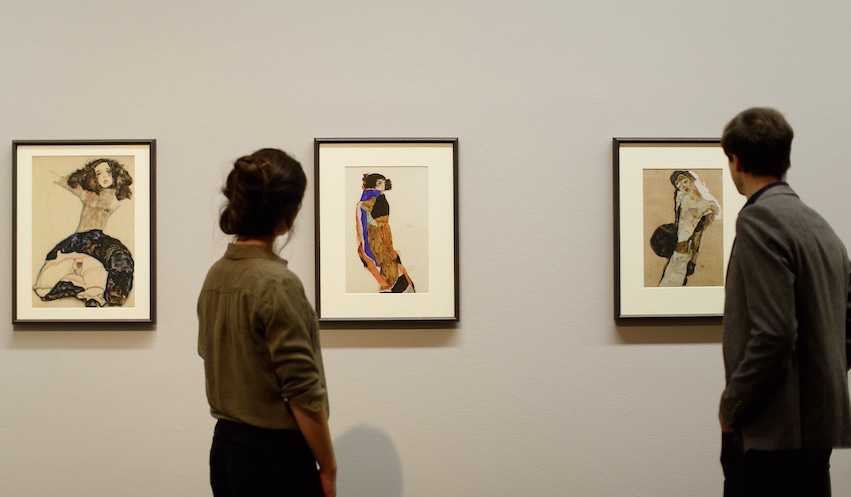
Museum-goers looking at paintings by Egon Schiele at the Leopold Museum. The museum has the largest collection of the Expressionist artist, who after a brilliant and controversial career because of his explicit nudes, died in 1918 at age 28 of the Spanish Flu. Photo by Peter Rigaud for Wientourismus
SOME FAVORITES
Belvedere Palace How about a kiss in a palace? “The Kiss,” the famous gold-hued painting of a couple embracing, has pride of place in the largest collection of paintings by the Austrian artist, Gustav Klimt (1862-1918). It’s displayed in the Belvedere Museum, housed in the 17th century palace with two stories above an extensive sculpture garden. Seeing “The Kiss” up close makes you wonder how eager the woman in the painting really is.
Hotel Altstadt. Art collector and world traveler, Otto Wiesenthal loved great hotels, so he created his own, hiring designers and architects to create 50 distinctive rooms, some with clawfoot bathtubs. Breakfast, as well as tea and cakes, are served in the cozy Red Salon, which is also used as a lobby. And of course, there’s always an art exhibit.
Restaurant – Zum Schwaren Kameel. In the chic first district that includes the Ring Boulevard, a busy counter near the entrance serves pastries and open-face sandwiches. Walk a few steps and you’re in an elegant restaurant serving an unlikely but luscious specialty: pieces of lobster and sauerkraut in a sauce of lobster broth, cream and paprika.
Vienna Woods
Vienna is one of the world’s greenest cities – almost half the city is made up of green spaces. Some are in elegant parks, built next to palaces such as the Belvedere and the Hofburg’s Volksgarten where you can sniff the dizzying scent of some 400 varieties of roses.
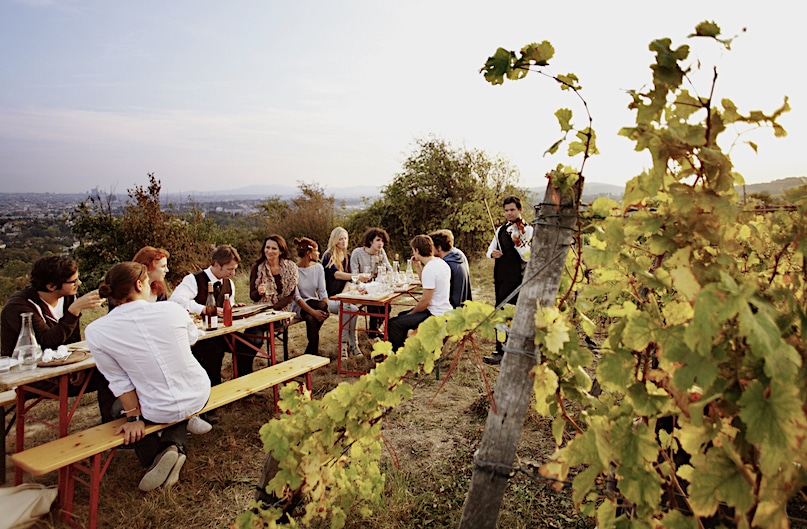
Wieninger am Nussberg / Wieninger vineyard on the Nussberg
One year ago, Vienna opened its first cooling center inside Esterhazy Park. The area is built around a 100-sq. ft. “coolspot”, with plants and misting sprays. If you arrive in Austria’s capital at the end of summer you’ll appreciate this place since it cuts ambient temperatures by around six degrees.
West of Vienna are the Vienna Woods, which has one of the largest self-contained deciduous forests in Central Europe. Walking trails and pastures, villages and woodlands, and a branch of the foothills of the Alps dot this varied area of over 40 square miles. In 2005 the Vienna Woods were designated a Biosphere Reserve by UNESCO, and Vienna became the only major city to be partially located within a Biosphere Reserve.
Also unusual are the wineries within its city limits. During the summer and fall, the Heuriges, as they are called, welcome visitors to taste their new wine on picnic tables laden with cold cuts and potato salad. Try the signature white wine called Grüner Veltiner for its crisp, young taste and aroma. The endearing Heurigen Express, an open-air locomotive, is a fun way to get there.
Travelers to Austria do not have to quarantine if they show either a negative PCR covid test taken within 72 hours or proof of vaccination or of full recovery from a past infection. From August 15, the same regulations apply to enter hotels, restaurants and nightclubs.![]()
Jacqueline Swartz was surprised by the pleasures of Vienna and would love to time travel to, say, 1908. If that is not possible, she hopes to return and make new discoveries.

